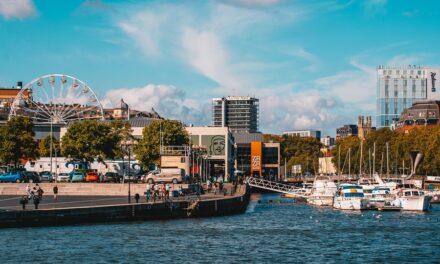MANCHESTER
On Wednesday 21st of August, 2019, me and
Brenda decided to go to Manchester as we didn’t
know it very well and I wanted to write this
article. We travelled directly by train from Halifax
to Manchester Victoria and the journey took about
fifty minutes.
On arriving in Manchester, we called in Costa
Coffee to have a soya hot chocolate in a pleasant
environment, but I was shocked that you had to
enter in a code to access a toilet!
From looking on the internet, we had discovered that we could get a tour bus from opposite
the Town Hall and so, because of time and because of Brenda’s lack of mobility, we caught a
bus at 12 pm. The tour around the city lasted for 90 minutes and cost £12 for adults and £6
for OAPs. The ticket was valid for two days and you could get on and off as you wanted at
designated stops.
Let’s now have a brief look at the history of the city of Manchester:
The name originates from the Latin name Mamucium, and its recorded history began in
AD79, when the Romans built a fort near the rivers Medlock and Irwell to protect their
interests from the major Celtic tribe called the Brigantes. Once the Romans had withdrawn
the Saxons came next and the Normans arrived after 1066.
Around the fourteenth century, there was an influx of Flemish weavers who established the
region’s textile industry.
Manchester really came into its own in the Middle Ages when it became an important centre
for the manufacture and trade of woollens and linen. However, after 1600, production of pure
cotton fabrics overtook production of wool. The number of cotton mills peaked at 108 in
1853.
During the Industrial Revolution, lots of cotton spinning occurred and, for a while,
Manchester produced the most cotton goods in the world. Significantly, the opening of the
Bridgewater Canal in 1761, halved the cost of coal and also the cost of transporting raw
cotton. Ironically, the Industrial Revolution brought not only wealth to Manchester but also
squalor for many. It is also worth noting that the Manchester Ship Canal opened in 1894
creating the port of Manchester and directly linking the city to the Irish Sea.
Unfortunately, the First World War interfered with export markets and this trend continued
after the Second World War when cotton processing and trading continued to fall.
There was a big effort to regenerate the city in the late 1980s with work on the Metrolink, the
Bridgewater Concert Hall, the Manchester Arena and the Salford Quays.
Tragically, on 15 June 1996, the IRA bombed part of the main shopping centre and caused a
final insurance pay-out of over £400 million. Happily, since this time, Manchester city centre
has experienced extensive regeneration and this was helped by the hosting of the
Commonwealth Games in 2002.
In recent times, we have witnessed more terrorism at the Ariana Grande concert, at the
Manchester Arena, when 23 were killed and over 800 people were injured. Let’s hope this
wonderful city does not suffer again in this way.
If you like shopping, you can visit the splendid Arndale Centre which is the UK’s largest
shopping centre. In addition, there are plenty of nice venues to dine and be entertained in like
the renovated complexes in the Printworks and the Corn Exchange.
Manchester is rich in architectural styles which range from Victorian to more contemporary
architecture. One of the most important Victorian buildings in England is Manchester Town
Hall which was built in the Gothic revival style. It is currently closed until 2024 for
refurbishment.
The city is celebrated for producing some of the top music acts in the world like: Simply Red,
10cc, Joy Division, The Smiths, Oasis and many more. There are numerous venues to visit
including Manchester Apollo, the Albert Hall, Manchester Academy, Manchester Opera
House, the Palace Theatre and the Royal Exchange Theatre.
If you have time, you might like to visit the reconstructed Roman fort of Manucium which is
to be found in Castlefield. If you like history, it might also be a good idea to visit the
Manchester Museum which contains collections of Egyptology and natural history. Also, if
you like the work of the artist Lowry, you can see some of his work in the City and
Whitworth Manchester galleries.
The city has six designated local Nature Reserves which are: Chorlton Water Park, Blackley
Forest, Clayton Vale, Chorlton Ees, Ivy Green, Boggart Hole Clough and Highfield Country.
It is very easy to travel from and to Manchester as you can use the train, Metrolink, the bus,
canal and also Manchester Airport which serves Manchester, Northern England and North
Wales.
If you are mad about football, you will be aware of the fierce rivalry between Manchester
City and Manchester United – both of whom are highly successful in their own right.
Manchester has also hosted the FIFA World Cup (1966), Olympic Football (2012), various
FA Cup finals and League Cup finals.
I found the city to have a lovely ambiance and I noticed that the main streets were very clean.
This article has provided a superficial look at the city of Manchester but I hope you will make
time to visit it yourself and discover its many treasures.
● With a lot of help from Wikipedia.
Dean’s Places can be found on FTHM here



Recent Comments